Temperature Tips for Brisket Burnt Ends
Though regional styles abound in BBQ, there is one place where they all come together: Kansas City. Known as the BBQ Capital of the World, KC has a rich and storied history, not to mention some serious BBQ clout—all the great BBQ competitions run on KCBS (Kansas City Barbeque Society) rules, even those in other states! That’s right, Memphis in May is run by Kansas City rules.
But even more importantly, Kansas City is the home of Brisket Burnt Ends. Ah, burnt ends…the fatty, rich, saucy, cubes of jelly-like meat made from the re-cooked point of the brisket. If you like the point of a brisket (and you should), then you’ll love burnt ends! Here, we’ll show you Meat Church BBQ‘s fantastic method for making killer burnt ends, complete with temperature tips. Grab a leave-in probe thermometer and let’s get cooking!
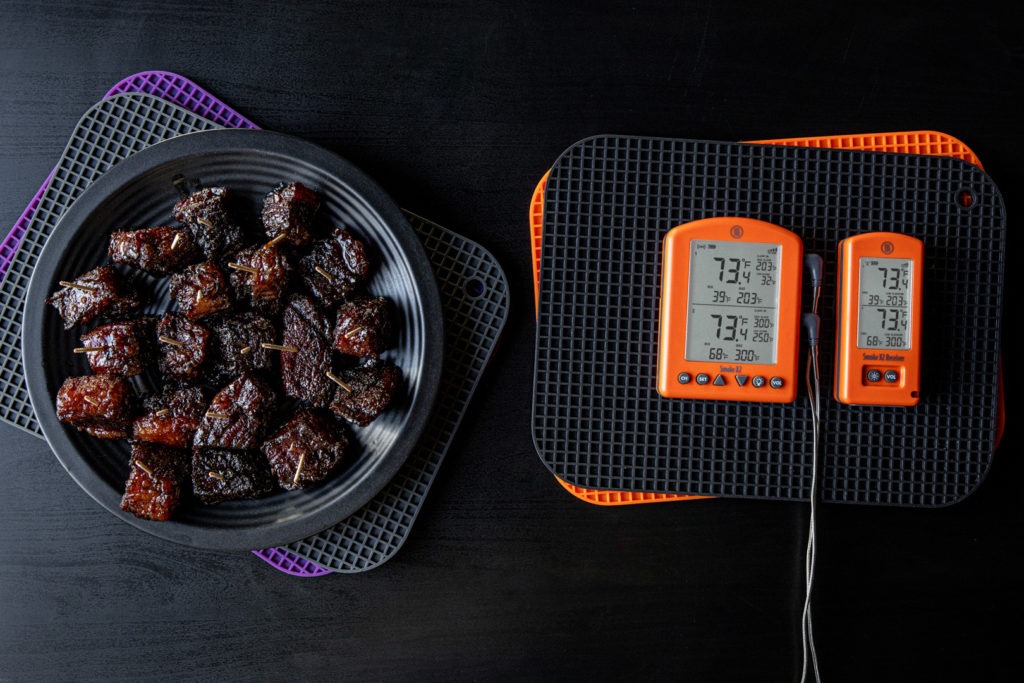
How to make burnt ends
Burnt ends are the result of a little bit of delicious kitchen alchemy whereby collagen is transformed into gelatin and sugar is thickened into syrup. It’s a long process, but well worth the effort.
Burnt ends start by cooking a whole brisket. Then, the brisket point is cut up into cubes, re-seasoned with rub to cover the newly-exposed cube faces, and lightly sauced before being put back on the heat to finish cooking and to set the sauce. Now, that’s an oversimplification of what is happening, so let’s take a closer look at the thermal principles at play in creating these delicious treats.
Brisket collagen breakdown
The point of the brisket is the smaller, fattier of the two muscles that compose a full packer brisket. This cut, riddled with connective collagen, is what true brisket fans crave, dripping with juice and sweet-tinged fat. Of course, any part of the brisket is practically inedible if not cooked properly, but the point, in particular, must be cooked long enough to break down all the chewy collagen in it.
Collagen dissolution generally starts at around 150°F (66°C) but doesn’t really get going until about 170°F (77°C). As with all brisket, this means that simply cooking the meat until it is “done” is not enough—cooked to 155°F (68°C), brisket would require some serious steak knives to cut into. Completely dissolving collagen—full gelatin transformation—takes a long time, so making burnt ends requires a long time. (If you’ve ever cooked brisket or read about it on our blog, you know about the infamous stall that the brisket goes through as the collagen melts. It takes a while.) Based on your time needs, you can choose either to crutch or not to crutch your brisket to move through the stall more quickly.
Either way, you don’t want to cook all the way through the stall before cutting it up. In fact, you want to pull your brisket from the heat when your point reaches 195°F (91°C). That’s the ideal temperature to cut it up because if it were much more tender, actually cutting it into cubes could prove difficult! The rest of the collagen is dissolved after the beef is cubed, dressed, and put back on the heat. The increased surface area of the cubes allows the heat to enter the meat more easily, raising the temperature much more quickly.
That being said, brisket burnt ends cooked to 195°F (91°C) are already quite tasty. They could be more tender, but the are pretty good already. So cooking to an exact 203°F (95°C), like we recommend for brisket generally, isn’t critical for the finished product. The critical temps you need to pay attention to are the 195°F (91°C) internal temp for the initial cook before cutting and 225°F (107°C) for your smoker. A leave-in probe thermometer like the Smoke X2™ can help you nail those critical temperatures, not to mention monitor the cook while it’s happening. Oh, and the Billows ™ fire-control fan can keep your smoker right on temperature while you’re sleeping. (Brisket takes 12+ hours to cook, you’ll need a nap.)
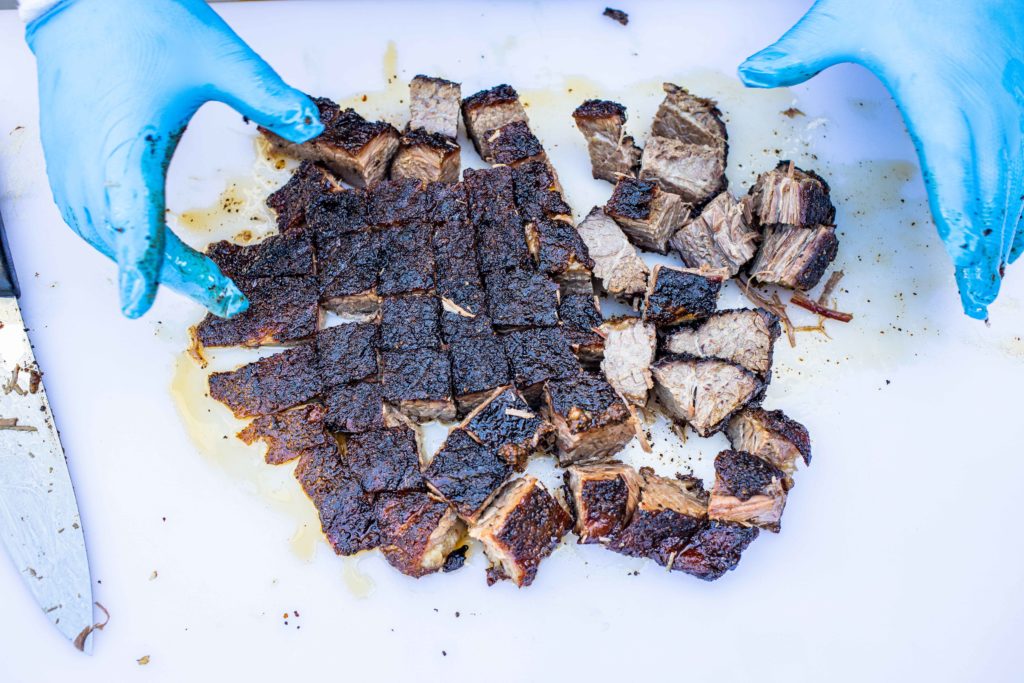
Burnt ends: candy coated? Almost!
The transformation of collagen into gelatin and the accompanying tenderization of the meat is only part of the transmutation of brisket into the golden nuggets that are burnt ends. The rest comes from the seasoning and sauce.
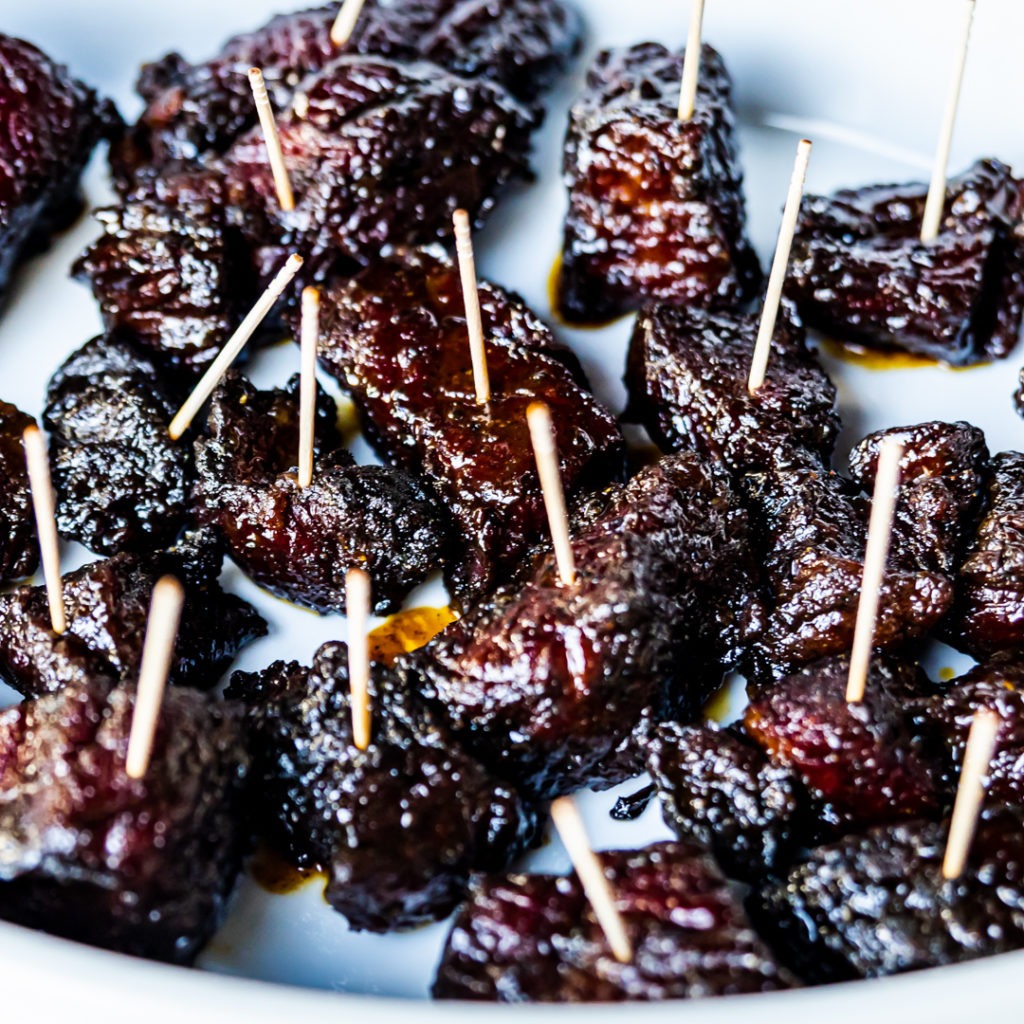
Burnt ends are so delicious partly because they are so heavily seasoned. Each cube is individually coated in rub. Matt Pittman over at Meat Church BBQ recommends using a blend of rubs, one that is more savory and another that is sweet, to strike a balance in the intense flavors that will be imparted to the meat.
And to make sure that the meat is fully well flavored, Matt adds an interesting step to the early preparation of the brisket. When trimming the excess fat from the brisket, also trim most of the point away from the flat, trimming out most of the deckle fat between the muscles. Separating the muscles allows you to season the top and bottom of the point before cooking so that the salt and spices can more fully incorporate into the meat during the long initial cook.
To separate the muscles, find the small seam of fat where the point connects with the flat on the point end of the brisket.
The seam located, use a sharp boning knife to seam-out the two muscles. Trim the point free except for the last inch or so connecting it to the flat. Trim out excess fat so that the point is nearly bare and the flat has a 1/4″ layer of fat.

Now when you season the brisket for cooking you can season in between the two muscles, giving your brisket a deeper flavor. When you cube up the meat, you’ll have two sides already seasoned! (Also, by removing the fat between the two muscles, you make the brisket much more uniformly shaped, helping it to cook more evenly.)
So what about that candy coating I was alluding to? Enter sauce. Giving the beef bites a light coating of sauce before recooking them means that the water in the sauce will partially cook out, thickening the remaining sauce until its flavors are concentrated and it becomes sticky. Note, though, that they are not caramelized. Sugars don’t caramelize until temperatures above 300°F (149°C). If you want true caramelization, you’ll have to blast your burnt ends with some real heat, but they don’t need it. They are fine on their own sticky merits.
Brisket Burnt Ends Recipe
Based on Brisket Burnt Ends, by MeatChurchBBQ.com
Ingredients
- 1 full packer brisket
- BBQ rub (your choice)
- BBQ sauce (your choice)
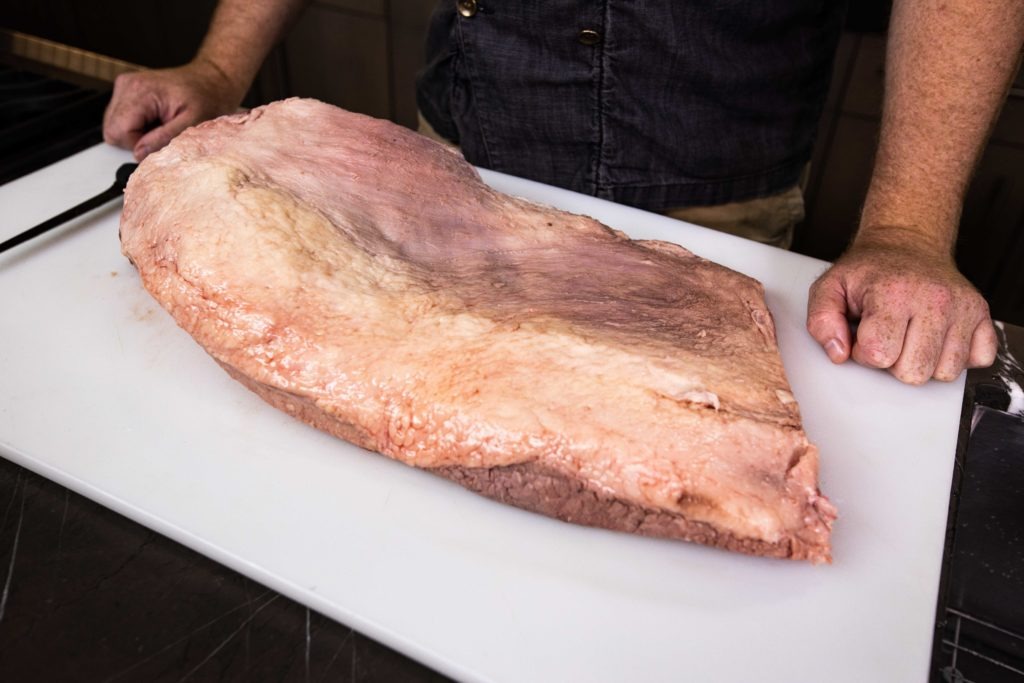
Instructions
- Trim your brisket as usual, leaving about 1/4″ of fat on the surface
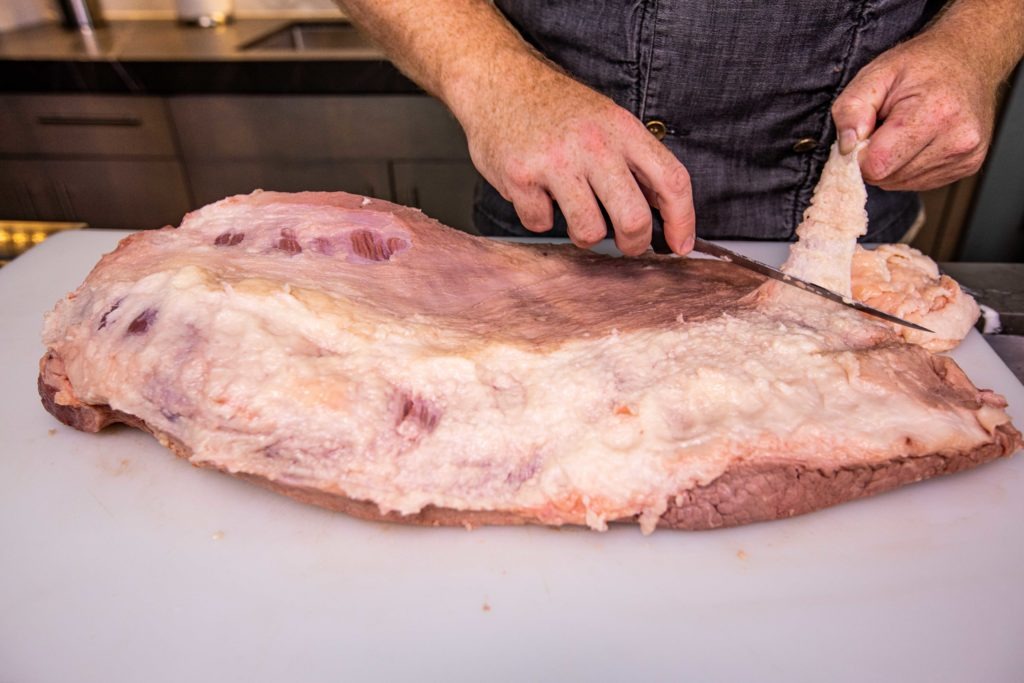
- Once your brisket is trimmed of excess fat, separate the point from the flat by cutting along the fatty seam between the two muscles, leaving about 1″ of connection between the two muscles. (See image above in the post.) Trim fat to 1/4″ on the flat side, remove as much fast as possible from the point side.
- Season the brisket all over with your favorite BBQ rub.
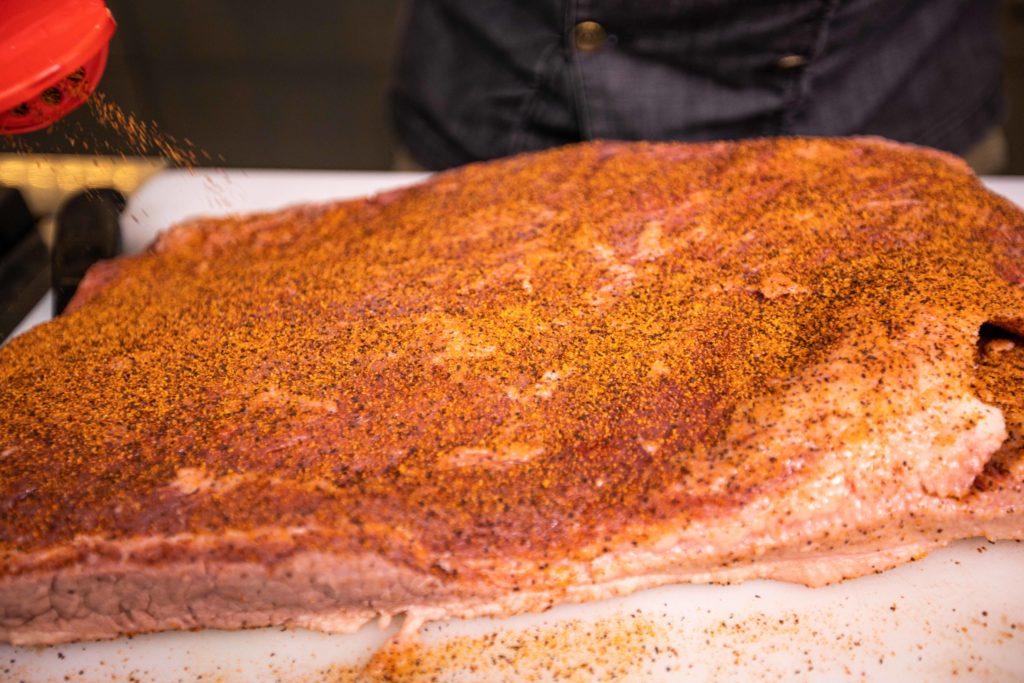
- Season the meat between the point and the flat for maximum flavor.
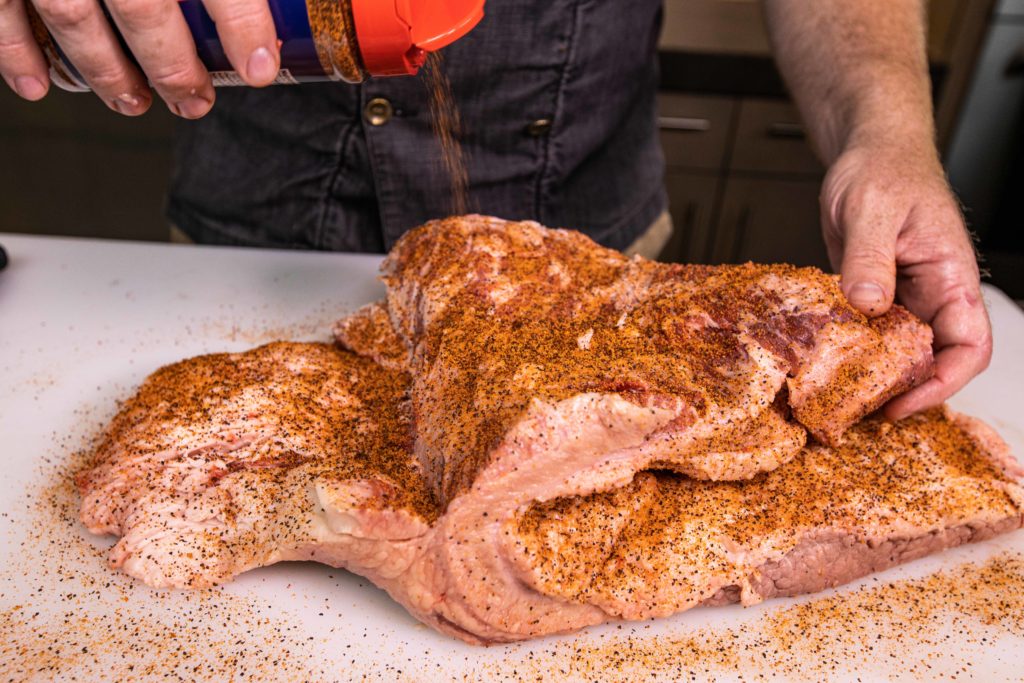
- Place your brisket on a preheated smoker.
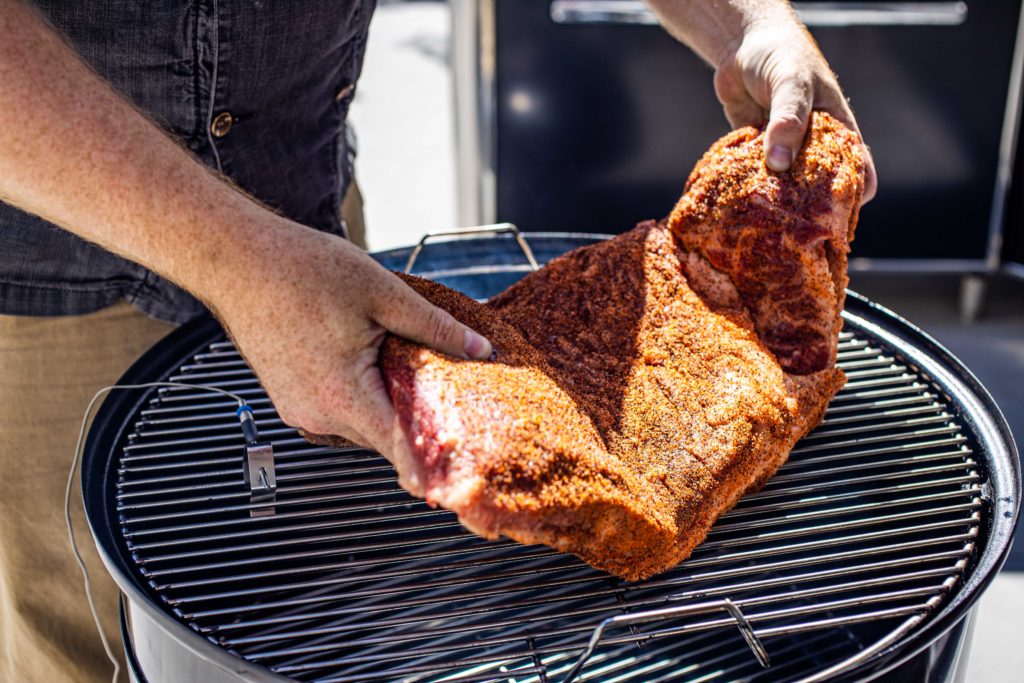
- Set up an air probe for the pit, and insert a probe into the point to monitor its temperature.
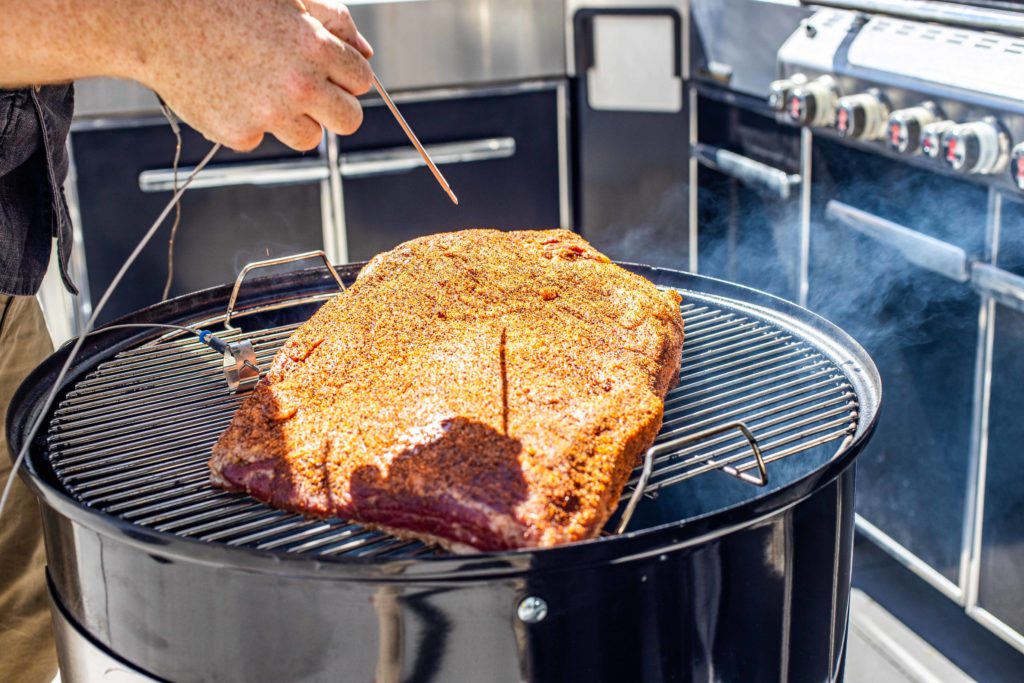
- Set the high-alarm for the point to 195°F (91°C) if you don’t plan on crutching your meat, or set the alarm for the temperature at which you want to crutch your brisket.
- If using, attach the Billows to your smoker and set the fan control temperature to 225°F (107°C).
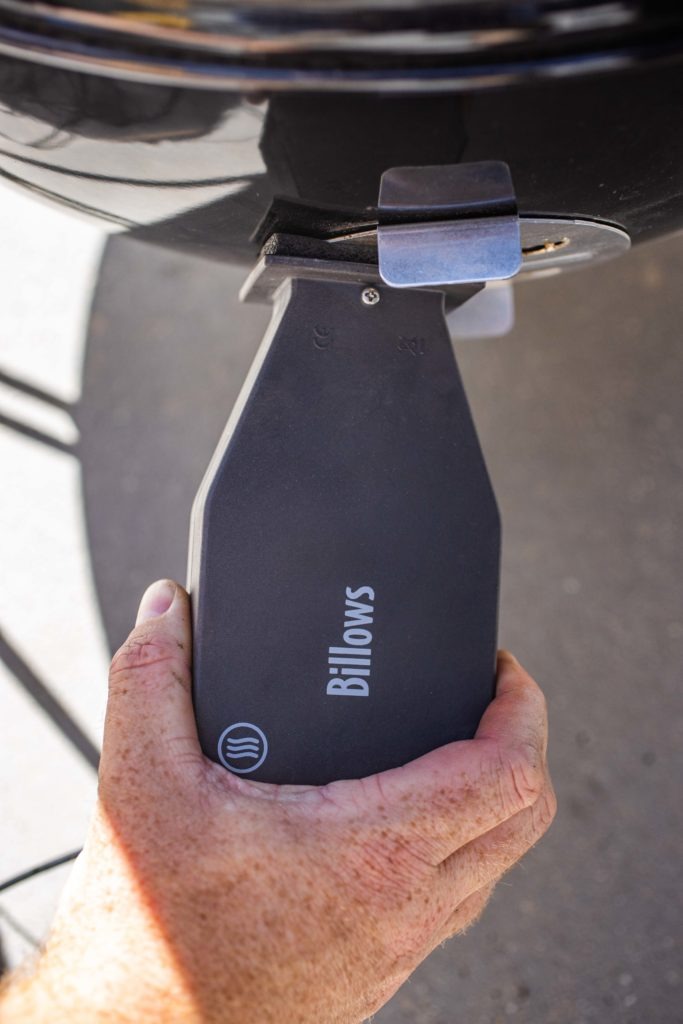
- When your brisket reaches 195°F (91°C), remove it from the smoker.
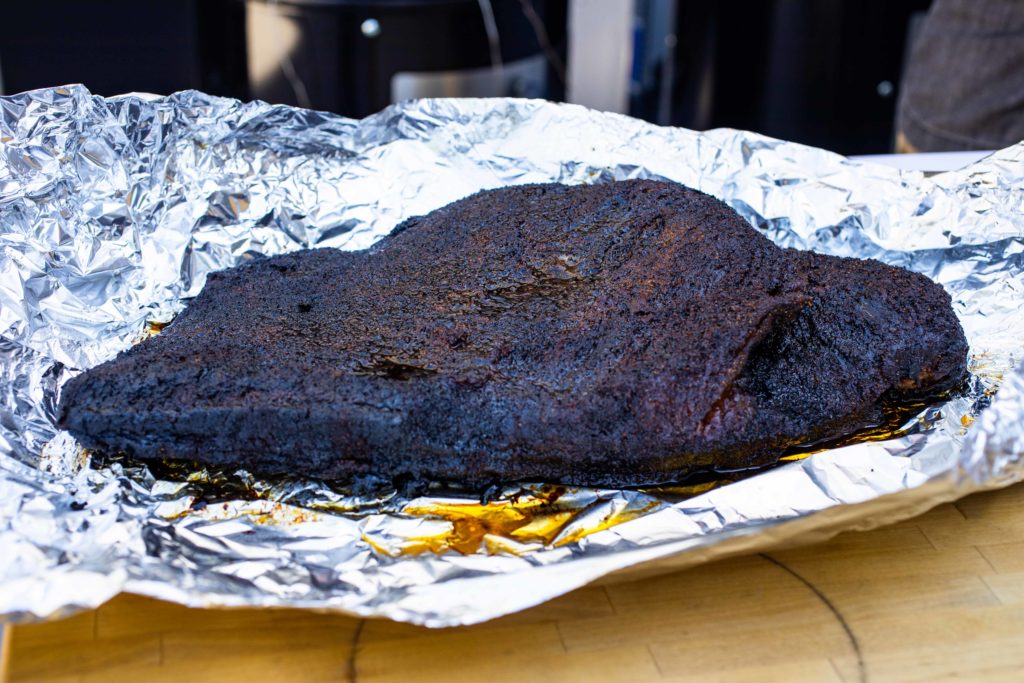
- Fully separate the point from the flat and cut the point into 1″ cubes. If the flat is not yet tender enough, you can continue to cook it alongside the burnt ends. If it’s ready to go, you can rest it a cooler to maintain temp until the ends are ready to go.

- Season the cubes with a nice dusting of rub, then toss them with a light coating of sauce.
- Place them in a pan that can accommodate them in one layer and return them to the smoker.
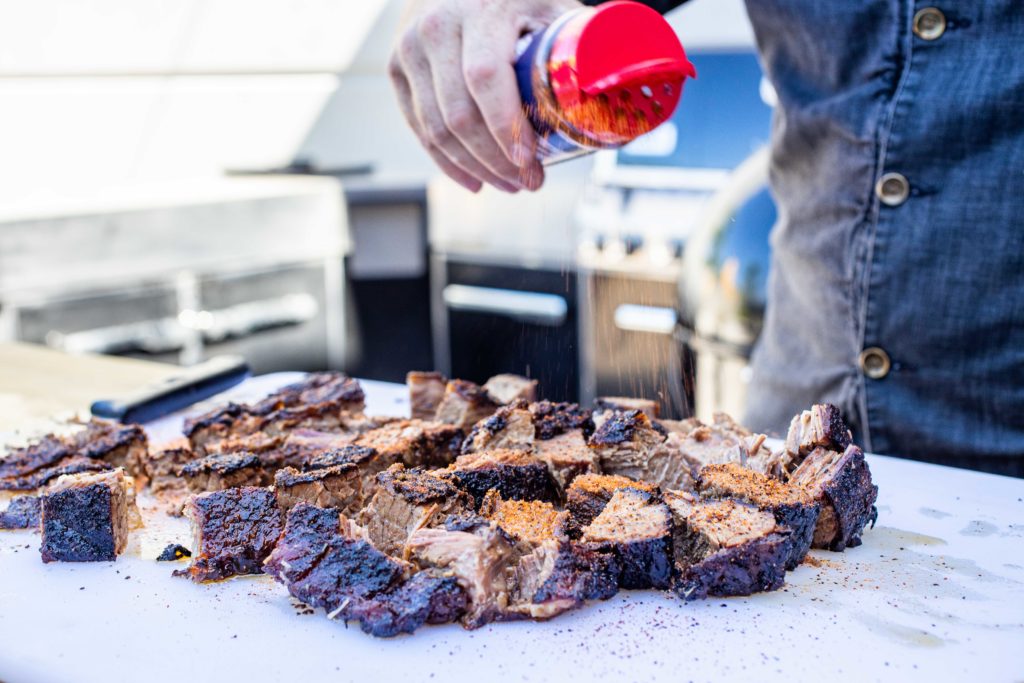
- Cook the cubes at 225°F (107°C) for another hour, until the sauce is thickened and sticky. You can speed things up by turning your Billows up a few degrees.
- Remove the burnt ends form the smoker and take a trip to sandwich Nirvana, or, why not, just eat them with some toothpicks…no need for any bread!
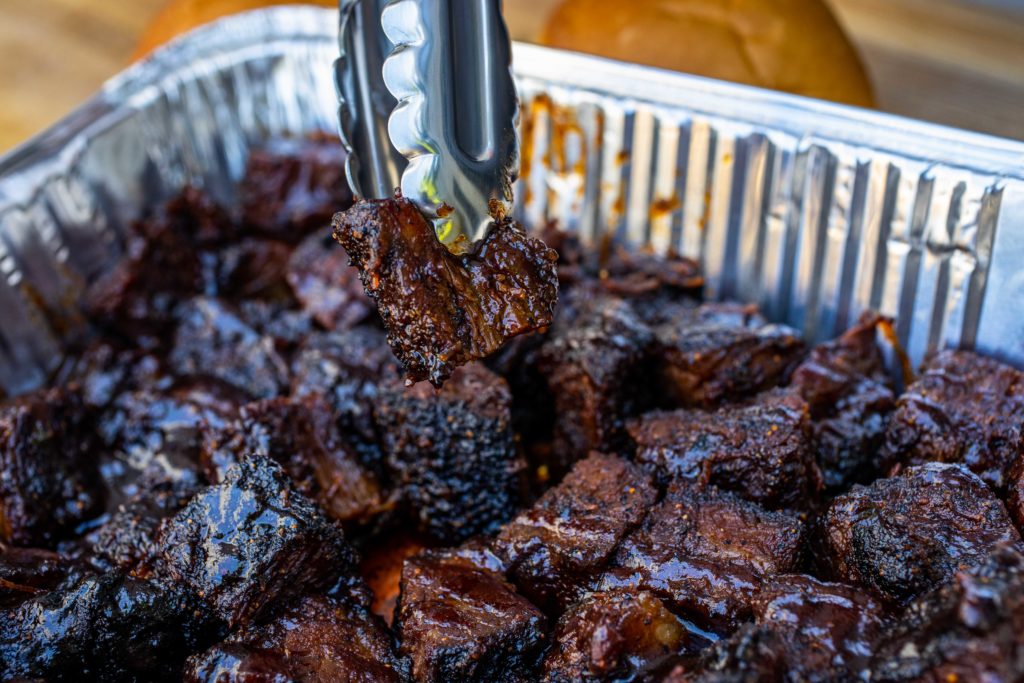
Adding any work at all to a brisket cook seems like foolishness. But the results you get from a little extra effort and a little extra seasoning are remarkable! And anyhow, if you use the long-distance abilities of the multi-channel Smoke X2 and the new Billows, most of the work is actually done for you. You don’t have to go all the way to Kansas City to treat yourself to the best bites of brisket you may ever eat!
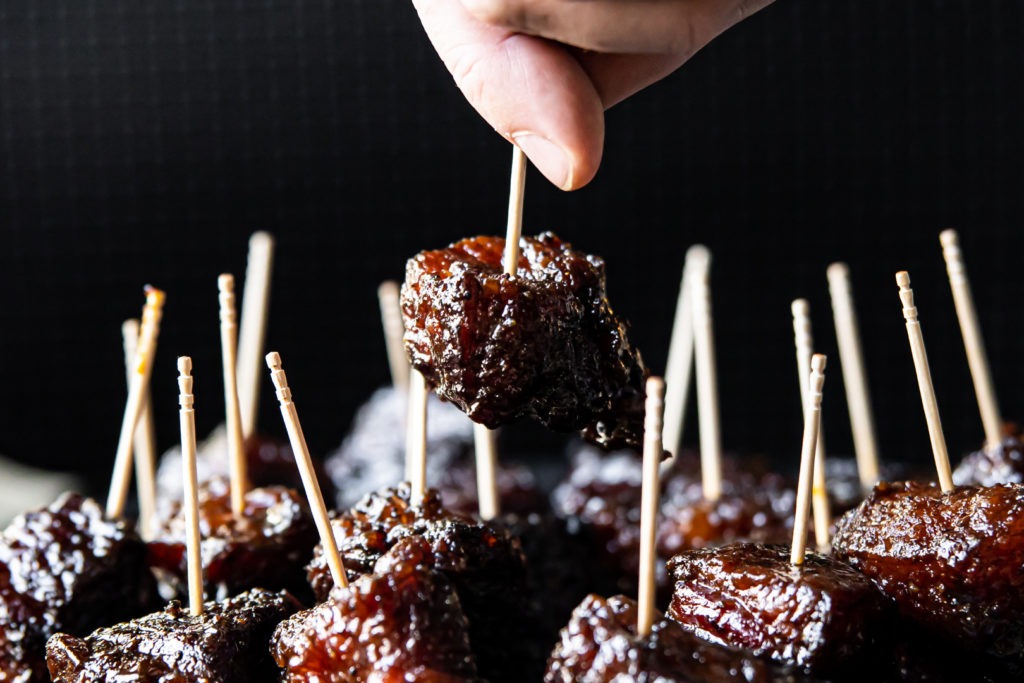
Shop now for products used in this post:


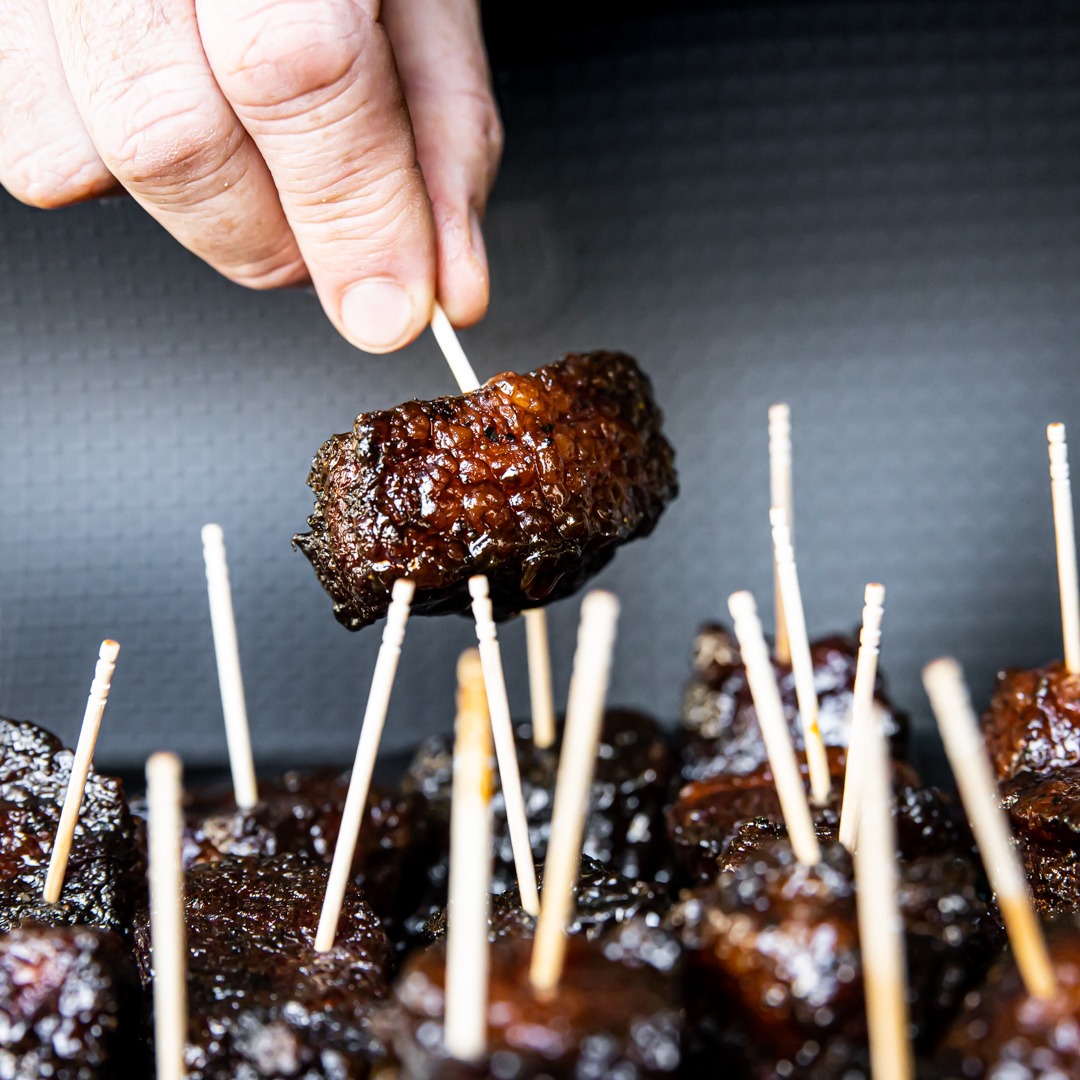
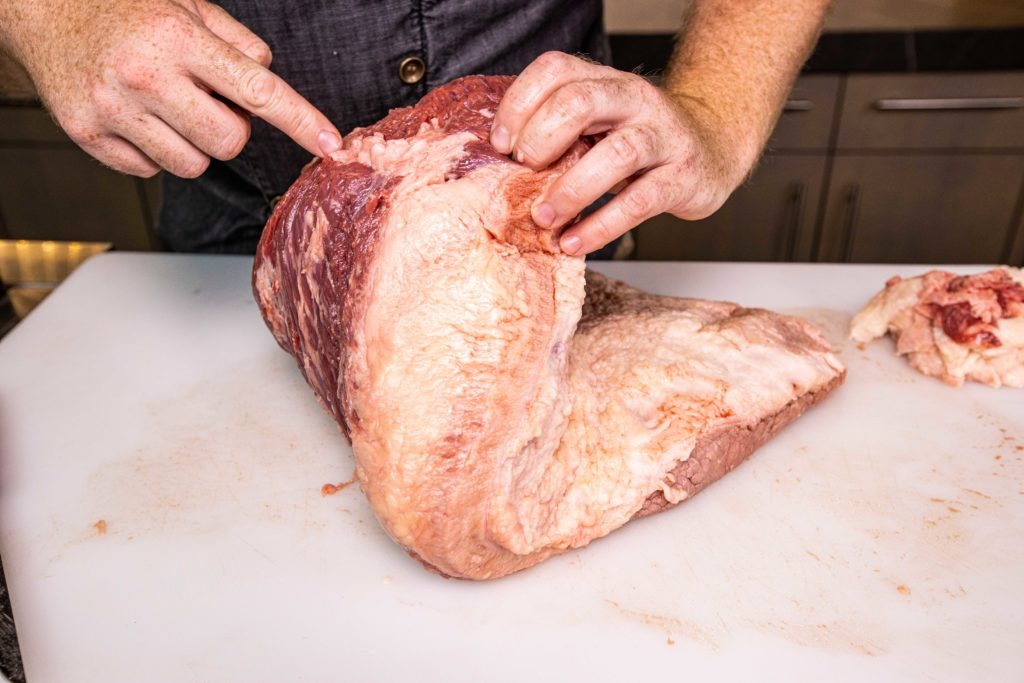

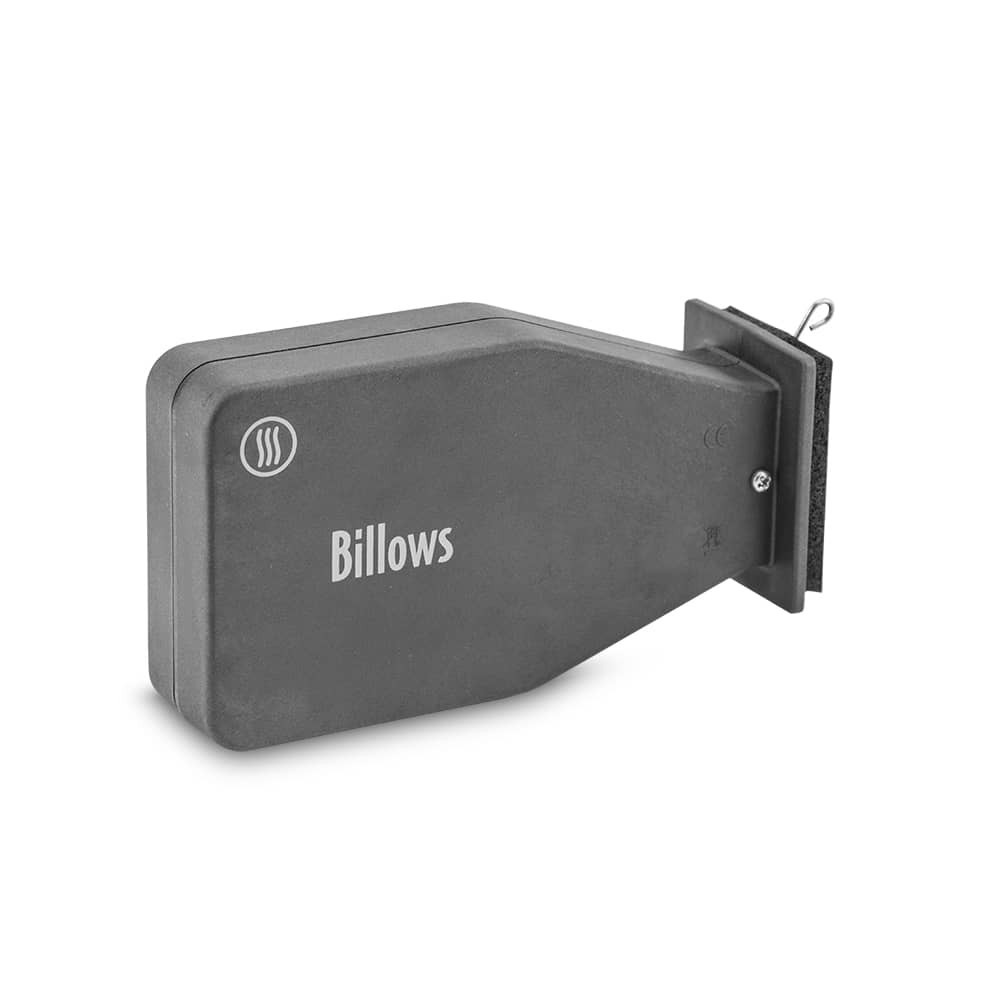
Will the Billows fan work with my Masterbuilt Electric Smoker? If so, how and where is it attached?
David,
No, it will not. Electric smokers regulate their own temperature, and Billows is made for smokers that don’t have any kind of internal temperature control. Your electric smoker has a built-in temperature control already.
I have a question, should i let the point rest after pulling from smoker, HOW LONG before i cut pt. into cubes, or cube it right after i pull it off the smoker…???? I cubed it right after cook put back on smoker for 20 min. seemed DRY and TOUGH. HELP, not wht i waned, 7 hrs cook, not a good finished product… 235 degree smoke till 165 then wrap till 200 ???? cut pt. then cubed. thks for any help…
Lawrence,
That method sounds pretty good in theory…strange that they were tough. Getting up to 200°F should have taken care of the texture. It is possible that the probe wasn’t in the thermal center and that it wasn’t cooked that high in the middle.
It is also possible (not knowing what you used) that the brisket itself was not great.
No, you don’t rest before cubing, but do cut it up immediately and put it back on the smoker. I’m not sure what happened with your cook, but I hope it works better for you if you try it again! Feel free to get hold of me with any other questions.
One thing I do to keep taste and moisture while smoking brisket is to spray with apple juice ever hour
Great recipes! Cannot wait to try it out!
It is possible, isn’t it, to cook a decent brisket on a gas grill, on indirect and using aromatic wood chips or chunks to generate smoke? After all, there’s no better temperature control (outside of an oven) than in a gas grill, assuming you don’t run out of gas, of course (in which case, your ambient air alarm should alert you).
I haven’t done it myself, but am thinking about it. Have you guys tried it? Not that it’s quite comparable to a brisket, but I hot-smoked a brined salmon fillet that way on indirect, and it came out great. (Of course, salmon only needs to get to 125 F before removal, and no collagen to gelatinize.) You gotta start somewhere!
Also, I know that it’s a “smoke”, but is there any logic to covering the brisket in foil at any point, the way one might do with turkey, to keep the more superficial layers from drying out? Or is that sacrilegious in the low-and-slow brisket smoking game?
Thanks for this blog. I’ve realized that a lot of grilling recipes out there use time, rather than temperature, as an end-point because they don’t consider the use of thermometers, which allow a truly much more reliable result. The ideas and recipes here allow me to also modify the cooking techniques I see in otherwise enticing recipes elsewhere, to account for the fact that I can actually do them right, using the magic of temperature feedback and control!
El,
Yes, you can absolutely do this on a gas grill as long as you get tath temperature in the right place! It may take a bit of fiddling with the flame before you find the constant temp you want, but it should work great. One thing to watch is that the temperature may vary based on external variables. If you cook overnight, for instance, your grill temp may go a little lower because the outside air is cooler and sucks the heat out more readily. Use an air probe to monitor the temp just to make sure that no external temperature fluctuations affect your grill temp adversely.
Happy cooking!
Good Afternoon,
That sounds like a great recipe for Burnt Ends.
I currently have a Electric Smoker but plan on upgrading soon.
My question is in regard to the Smoker pictured in the article.
It looks like the Weber Smoker? What size was the brisket used on the
Weber Bullet Smoker. The step separating the point from the flat sounds awesome.
Thanks.
It’s been a while since we did that cook, but, as I recall, it was probably about 12 pounds.
Thanks Martin,
I thought a 16lb/17lb full packer brisket might not fit on the Weber.
Hi Martin,
I too noticed that you were using a Weber smoker. I’m curious if you use the water pan when cooking your brisket?
Also, do you normally crutch your brisket?
Thanks!
I often use a water pan if I’m planning on cooking unwrapped the whole time. If I crutch, I usually omit it.